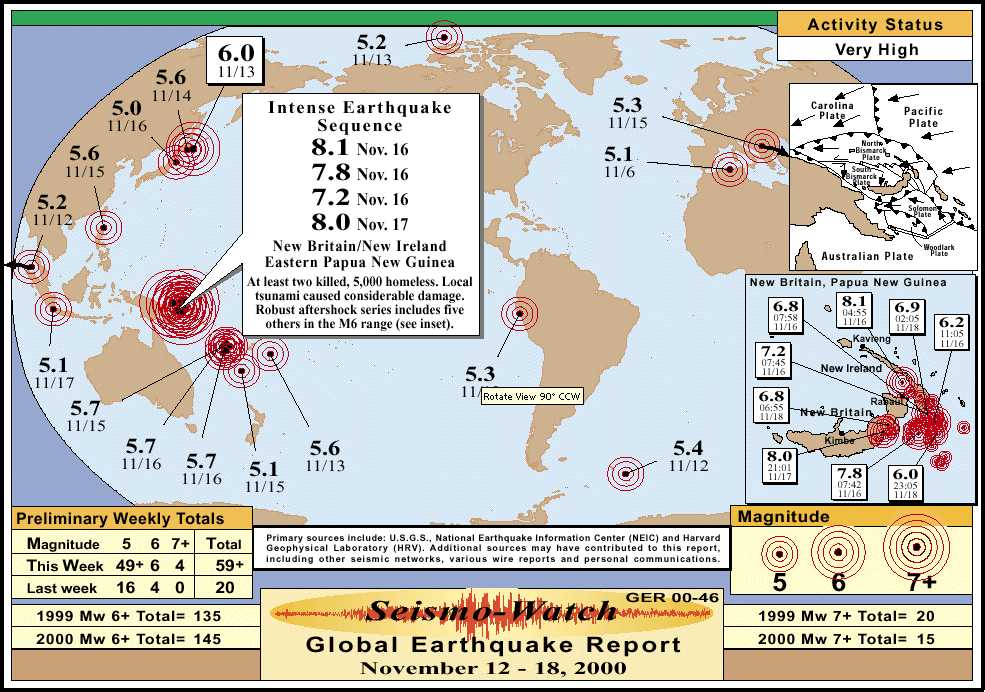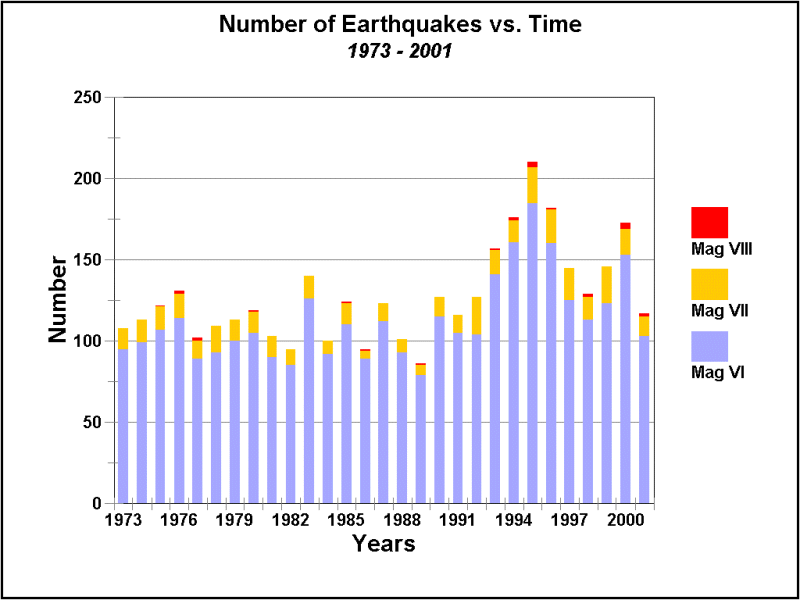Archived Articles
Equatorial South Pacific's
Paroxysm Of Intense Seismicity
Significance To Cayce's Pole-Shift and Earth-Changes Predictions
The week of November 12 - 18, 2000, saw one of the strongest displays of seismicity to take place in the south Pacific in many years. Off the northeastern shore of Papua, New Guinea, Indonesia, lie the Islands of New Britain and New Ireland. The town of Rabaul lies at the extreme northeastern tip of New Britain. There, on November 16, a great (M8.1) quake struck 20 miles north of Rabaul, about half way across the St. George Strait to New Ireland. The quake produced a local tsunami that surged as high as 10 ft on Bougainville.
This great release of seismic energy was a bit surprising because a strong M6.9 earthquake had occurred two weeks earlier on October 29 off the southern tip of New Ireland. This was followed by a series of aftershocks, including an M6.0 on November 7. The M8.1 of November 16 was followed by an aftershock sequence that produced at least six M5s in the first three hours. The pattern of the aftershocks suggested that a fault rupture extended southeastward across the southern tip of New Ireland into the Solomon Sea. Then, once again on November 16, a major (M7.8) quake struck at the southern end of the aftershock trend. The fault-plane solution for this quake, however, indicated that the rupture was along a northeastern trending plane separating the South Bismark and the Solomon microplates. See the map below for locations of these plates.
 The map shown above is courtesy of Advanced Geologic Exploration, Box 18012, Reno, NV, 89511-8012. It is used by permission of the owner, Charles Watson. Check out Watson's useful and informative website at www.seismo-watch.com.
The map shown above is courtesy of Advanced Geologic Exploration, Box 18012, Reno, NV, 89511-8012. It is used by permission of the owner, Charles Watson. Check out Watson's useful and informative website at www.seismo-watch.com.The aftershock sequence of the M7.8 quake was more intense and consisted of at least 15 M5s, an M6.8 and an M6.2 quake, and one temblor as large as M7.2. Then, 36 hours after the initial M8.1 quake another great (M8.0) quake struck beneath the eastern portion of New Britain. This was followed by intense aftershocks that produced three M6s, two of which measured M6.8 and M6.9. All in all, quite a display of seismicity for the period, although all of the quakes were relatively shallow for this part of the world.
As for the relevance of the foregoing to the Cayce Earth change predictions, our minds leap to reading 311-8 (4/9/32), which reads as follows:
Q How soon will the changes in the Earth's activity begin to be apparent?
A When there is the first breaking up of some conditions in the South Sea (that's South Pacific, to be sure), and those as apparent in the sinking or rising of that that's almost opposite same, or in the Mediterranean, and the Etna area, then we may know it has begun.
This reading goes on to say that 1936 would "see the greater changes, to be sure." In my book, Coming Earth Changes, I interpreted this to mean that Cayce's source was referring, via psychic cognition, to the enormously important "upheavals in the interior of the Earth" that had been predicted in other readings to occur in 1936. I also stated that I thought that rising or sinking of the land in the Etna, Sicily, area had already occurred, and that the most-likely area almost opposite to the Mediterranean area would be the tectonically active Kermadec-Tonga Trench area northeast of New Zealand. This is the location of Earth's most active zone of mantle seismicity, which is arising from the subduction of the Pacific plate along the trench. About two-thirds of global deep quakes are located there.
 Graph Showing Frequency of Occurrence of M6 - M8 Quakes vs. Time. Note That The Bar For 2001 Is Up To Date Only Through September
Graph Showing Frequency of Occurrence of M6 - M8 Quakes vs. Time. Note That The Bar For 2001 Is Up To Date Only Through SeptemberAnd so, just what is the significance, if any, of last year's earthquake sequence in the Rabaul area to Cayce-predicted Earth changes? The Rabaul-area quake sequence is quite possibly an important aspect of a worldwide increase in seismicity that may presage pole shift. And it is pole shift that will in turn produce historically-unprecedented, seismo-tectonic Earth changes of a catastrophic nature. It is the M6.0 and larger quakes that are the important ones to watch because they release so much more energy than the smaller ones on Richter's scale of earthquake magnitude. And the frequency of occurrence of M6+ earthquakes is essentially independent of the increasing use of sensitive seismic measurement equipment that has led to a significant increase in the numbers of reported smaller quakes over the last few decades. Thus, we note with Charles Watson of Seismo-Watch, that "the worldwide production of earthquakes registering M6.0 or stronger [in 2001] is on a pace to exceed the general annual average of 120 by about 20%. However, this elevated level of activity has been normal for the last decade or so, but significantly above normal for the decade of the 1970s and 1980s."
